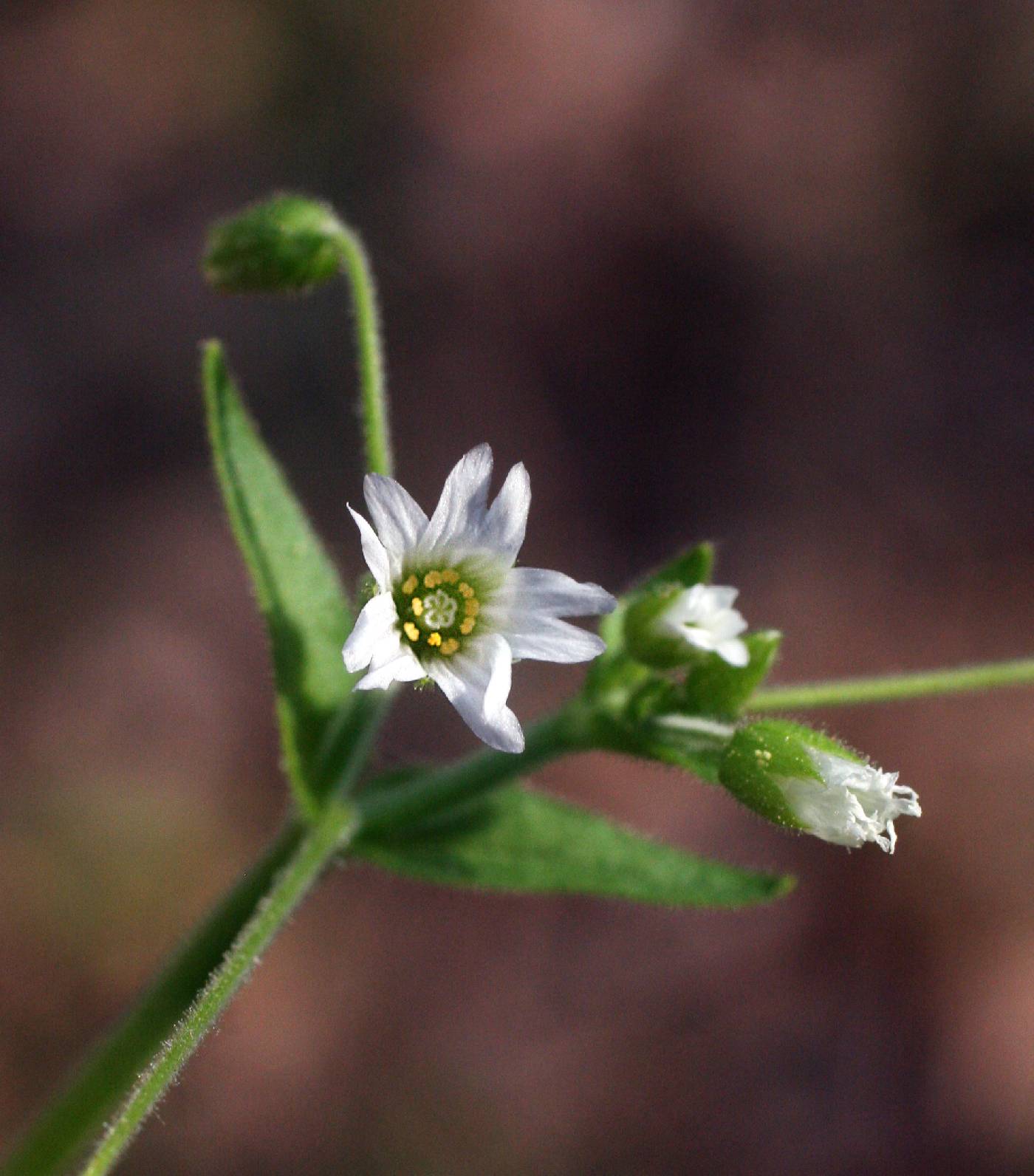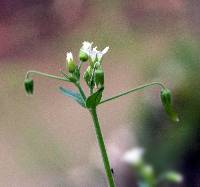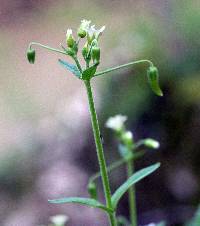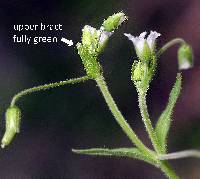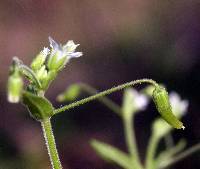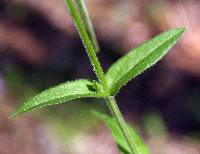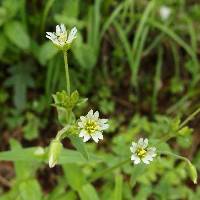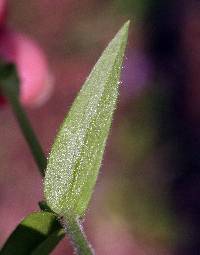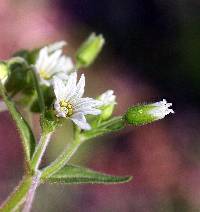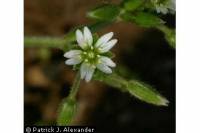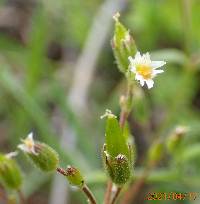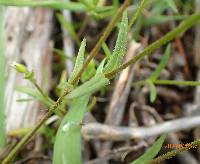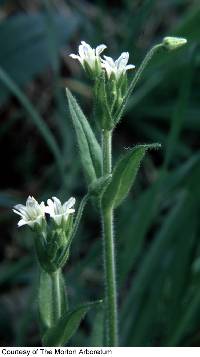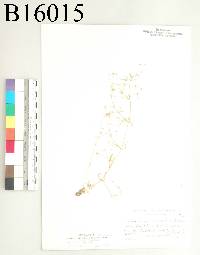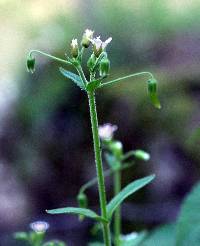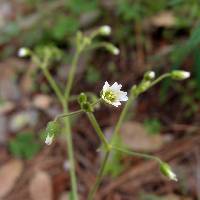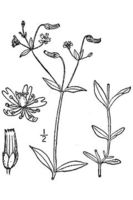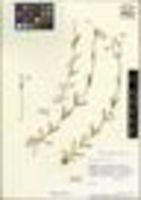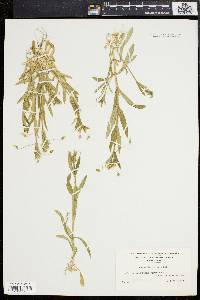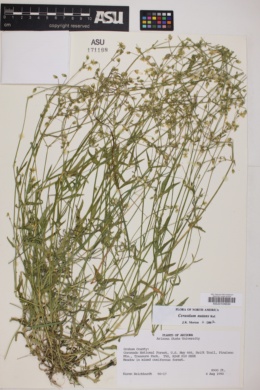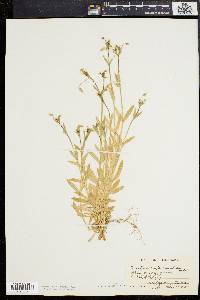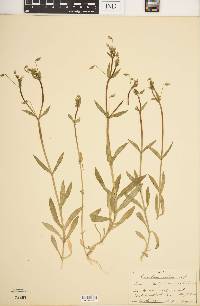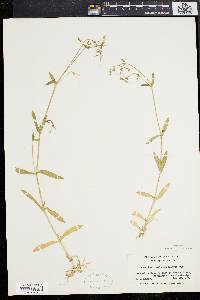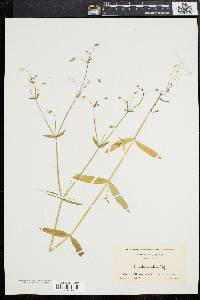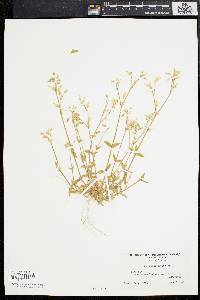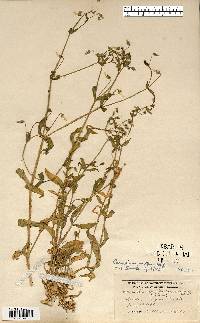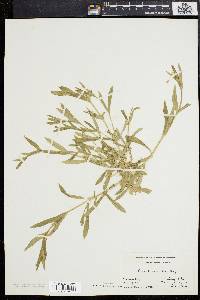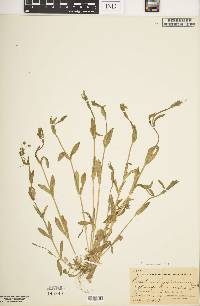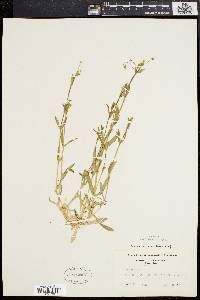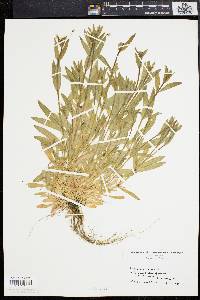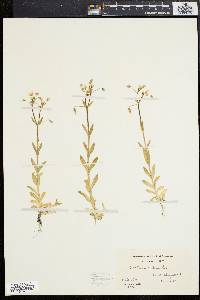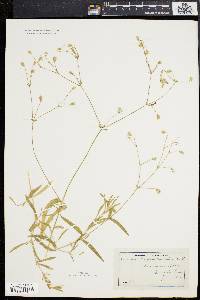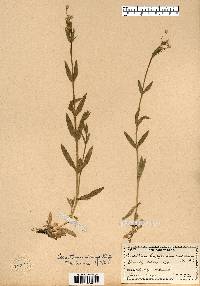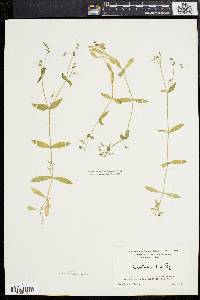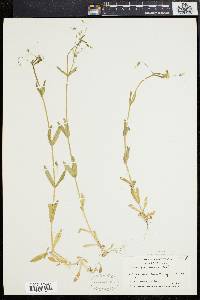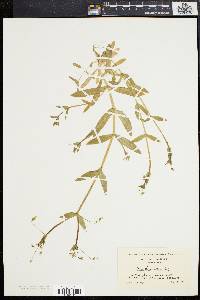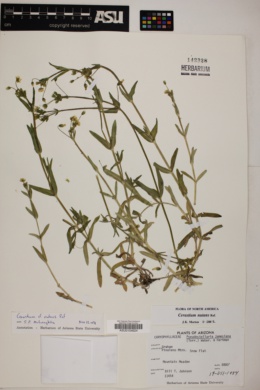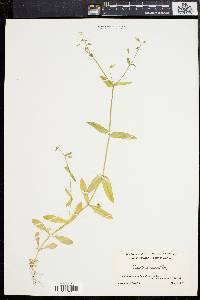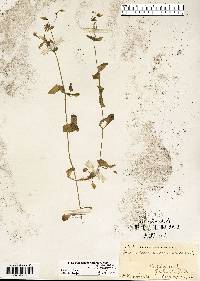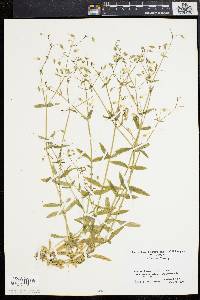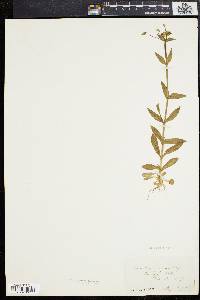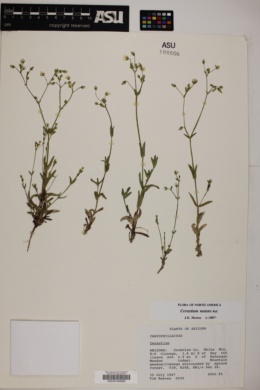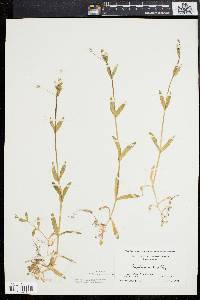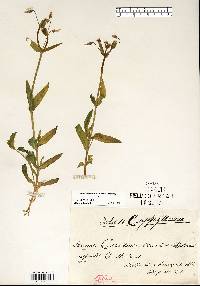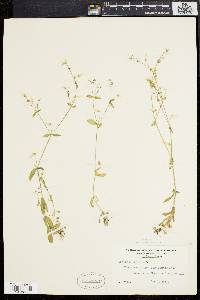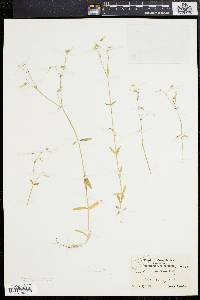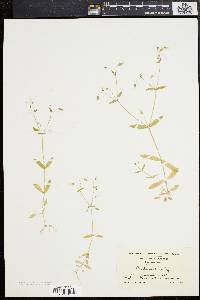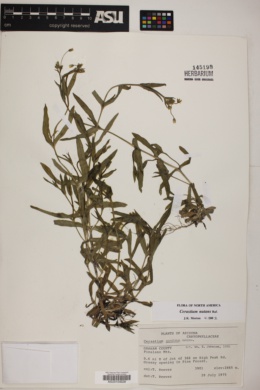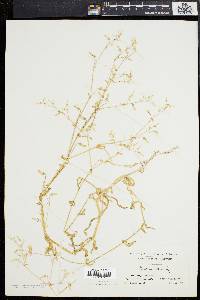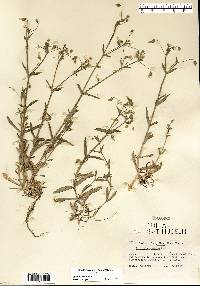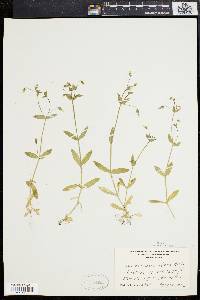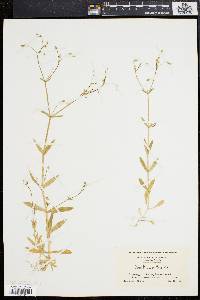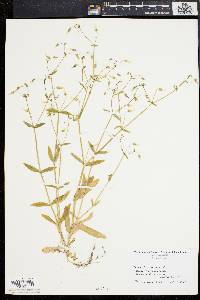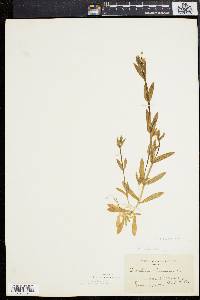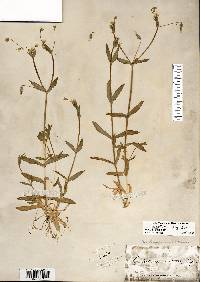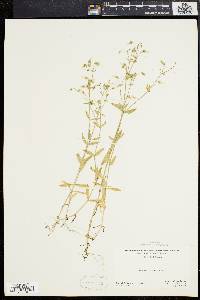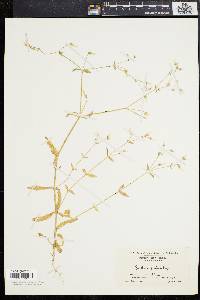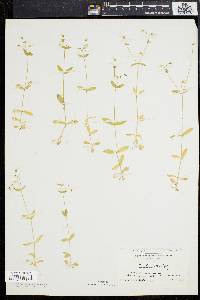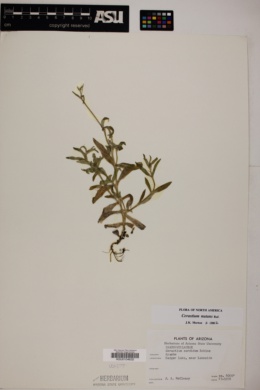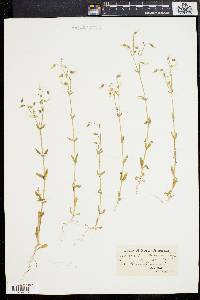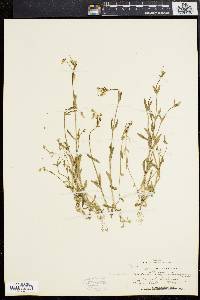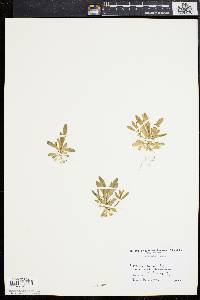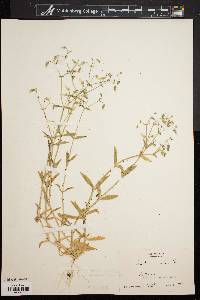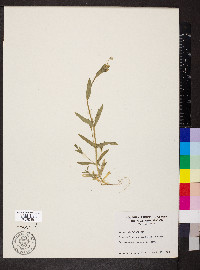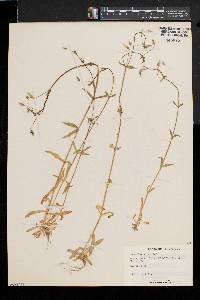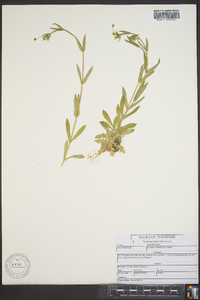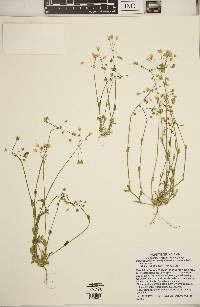Cerastium nutans
|
|
|
|
Family: Caryophyllaceae
Nodding Mouse-Ear Chickweed, more...common chickweed, longstem chickweed, nodding chickweed
[Cerastium apricum] |
Plants annual, slender, finely glandular-pubescent (often per-ennial and tomentose in var. obtectum), with slender taproot. Stems erect, simple or branched at or near base, sometimes with straggling, nonflowering basal shoots, 10-50 cm, softly pubes-cent, often with a few long, flex-uous, woolly hairs at proximal nodes, glandular and somewhat viscid distally; small axillary tufts of leaves usually absent. Leaves marcescent or not, sessile; blade oblanceolate to spatulate in proximal leaves, becoming lanceolate to linear-lanceolate in distal leaves, occasionally elliptic, 10-60 × 3-15 mm, apex acuminate to acute, softly pubescent and glandular, sometimes tomentose. Inflorescences rather open, 3-21(-40)-flowered cymes, ultimately widely branched; bracts herbaceous, lanceolate, glandular-pubescent. Pedicels ascending, sharply deflexed at apex in fruit, 5-20(-35) mm, usually 1-3 times as long as sepals in flower, elongating to 5 times as long as sepals in fruit, longer than capsules, glandular-pubescent and viscid. Flowers: sepals ovate-lanceolate, 4-6 mm, outer sepals herbaceous or with narrow margins, inner with margins ca. as wide as herbaceous center, apex broadly acute to obtuse, glandular-puberulent, hairs shorter than sepal tips; petals oblanceolate, sometimes absent, 3-6(-8) mm, shorter to 1.5 times longer than sepals, apex 2-fid; stamens 10; styles 5. Capsules cylindric, curved, (9-)10-12(-13) mm, 2-3 times as long as sepals; teeth 10, erect, margins convolute. Seeds golden brown, 0.5-0.8 mm diam., shallowly tuberculate; testa not inflated. 2n = 34, 36. Annual herb with a slender taproot 10 cm - 0.5 m tall Stem: upright, unbranched or branched at the base, softly hairy, glandular, sometimes with sterile basal shoots. Leaves: opposite, stalkless, 1 - 6 cm long, 0.5 - 1.5 cm wide, reverse lance-shaped to spatula-shaped (lower) or lance-shaped to linear lance-shaped (upper), softly hairy, glandular. Inflorescence: a more or less open, loose cluster (cyme) of three to twenty or more flowers subtended by glandular-hairy, lance-shaped bracts. The bracts are entirely green and lack scarious (dry, thin, and membranous) margins. Flowers: white. Stalk ascending, 0.5 - 2 cm long, glandular-hairy, sticky. Stamens ten. Styles five. Sepals: five, distinct, 3.5 - 6 mm long, relatively broad, egg- to lance-shaped with a blunt tip, thin, glandular-hairy. Petals: five, sometimes absent, white, 3 - 6 mm long, reverse lance-shaped, two-lobed, clawed. Fruit: a dehiscent capsule (opening by ten short, upright teeth), 10 - 12 mm long, longer than the sepals, cylindrical, curved. The stalks are longer than the capsules. Seeds numerous, golden brown, egg- to kidney-shaped, dorsally grooved. Similar species: Having entirely green, non-scarious bracts helps to distinguish this species, Cerastium brachypodum, and C. glomeratum from most other Cerastium in the Chicago Region. Cerastium brachypodum and C. glomeratum differ from C. nutans by having fruit stalks that are shorter than or about equal the length of the capsules. Flowering: March to June Habitat and ecology: Found in many habitats, but in the Chicago Region it is most frequent in nursery plots, fire lanes, fallow fields, and other areas with relatively low competition. May also be found in rich woods and other moist areas. Occurence in the Chicago region: native Etymology: Cerastium comes from the Greek word keras, meaning horn, referring to the horn-like shape of the seed capsule. Nutans means nodding. Author: The Morton Arboretum FNA 2005, Kearney and Peebles 1969 Duration: Annual Nativity: Native Lifeform: Forb/Herb General: Small herb 10-50 cm, stems ascending, lax, or prostrate and mat forming, pubescent to tomentose, often with a few extra-long hairs at the nodes, glandular and viscid, especially near the base. Leaves: Opposite and clasping, lanceolate with acuminate tips distally, oblanceolate to spatulate proximally, pubescent, glandular, or tomentose. Old leaves tend to be persistent. Flowers: Inflorescences open, with flowers borne in cymes of 3-21, widely branched at the top of the stems, pedicels ascending, sharply deflexed at the apex when fruiting, sepals ovate to lanceolate, hairs at tips not extending much beyond the end of the sepal. Flowers with 5 white petals, deeply divided so that the flower appears to have 10 petals, with 5 styles and 10 stamens. Petals can be shorter or up to 1.5 times as long as the sepals. Fruits: Curved, cylindric capsules, 10-12 mm, with convolute margins and 10 teeth. Seeds golden brown. Ecology: Found in sandy canyons and washes, pine woodlands, and among rocks in arid uplands from 7,000-9,500 ft (2134-2896 m); flowers May-October Notes: This species appears similar to another Cerastium fontanum, the key differences are difficult to determine. Ours is likely var. obtectum which is said to intergrade with var. nutans. FNA indicates that most of these intermediate type varieties, so collections are worthwhile. Ethnobotany: Unknown Synonyms: Many, see Tropicos Editor: LCrumbacher, 2011 Etymology: Cerastium comes from the Greek keras, "a horn," referring to the shape of the seed capsule. Viscid-pubescent annual 1-4.5 dm, mostly softer and leafier than our intr. spp.; lvs narrowly lance-oblong to oblanceolate, 1.5-5(-8) cm נ5-10(-13) mm, acutish; infl ±open, loosely cymose; bracts wholly herbaceous; sep 3.5-5 mm, relatively broad, thin, and blunt, thinly to fairly copiously provided with short to fairly long, sometimes gland-tipped hairs that do not surpass the sep-tip; pet from a little shorter to evidently longer than the sep; bifid to a depth of mostly 1-2 mm, or seldom wanting; stamens 10 or seldom (especially in apetalous forms) only 5; fr 8-15 mm, straight or curved, mostly 2-3 times as long as the sep. 2n=34-36. Woods and open places, sometimes in disturbed sites, but not so weedy as our intr. spp.; N.S. to Mack., s. to Ga., Ariz., and Oreg. Apr.-July. (C. brachypodum (A. Gray) B. L. Rob., the arbitrarily delimited, geographically coextensive phase with pedicels mostly 0.5-1.5 cm, instead of 1.5-4 cm as in typical material) Gleason, Henry A. & Cronquist, Arthur J. 1991. Manual of vascular plants of northeastern United States and adjacent Canada. lxxv + 910 pp. ©The New York Botanical Garden. All rights reserved. Used by permission. |
|
|
|

